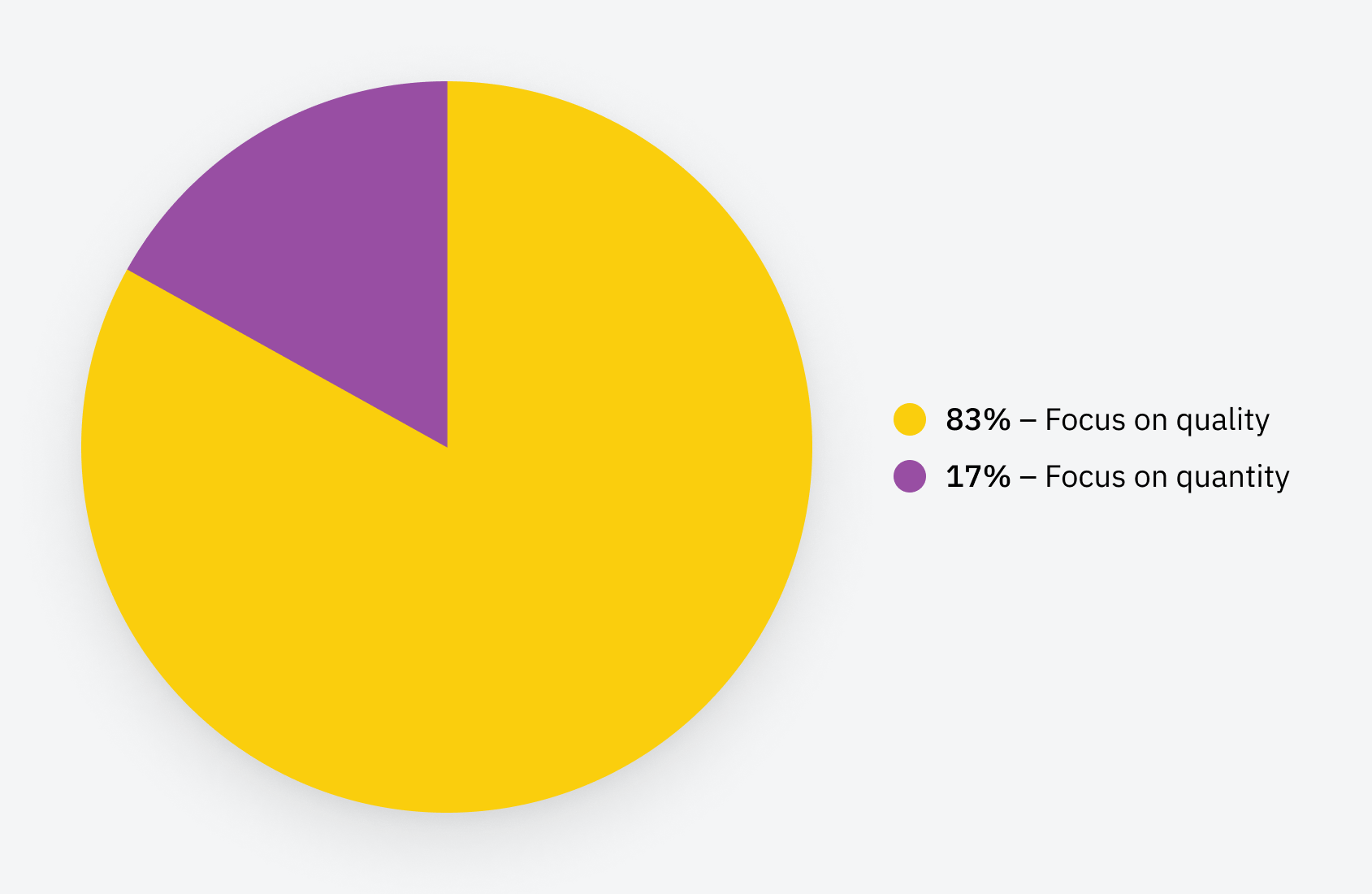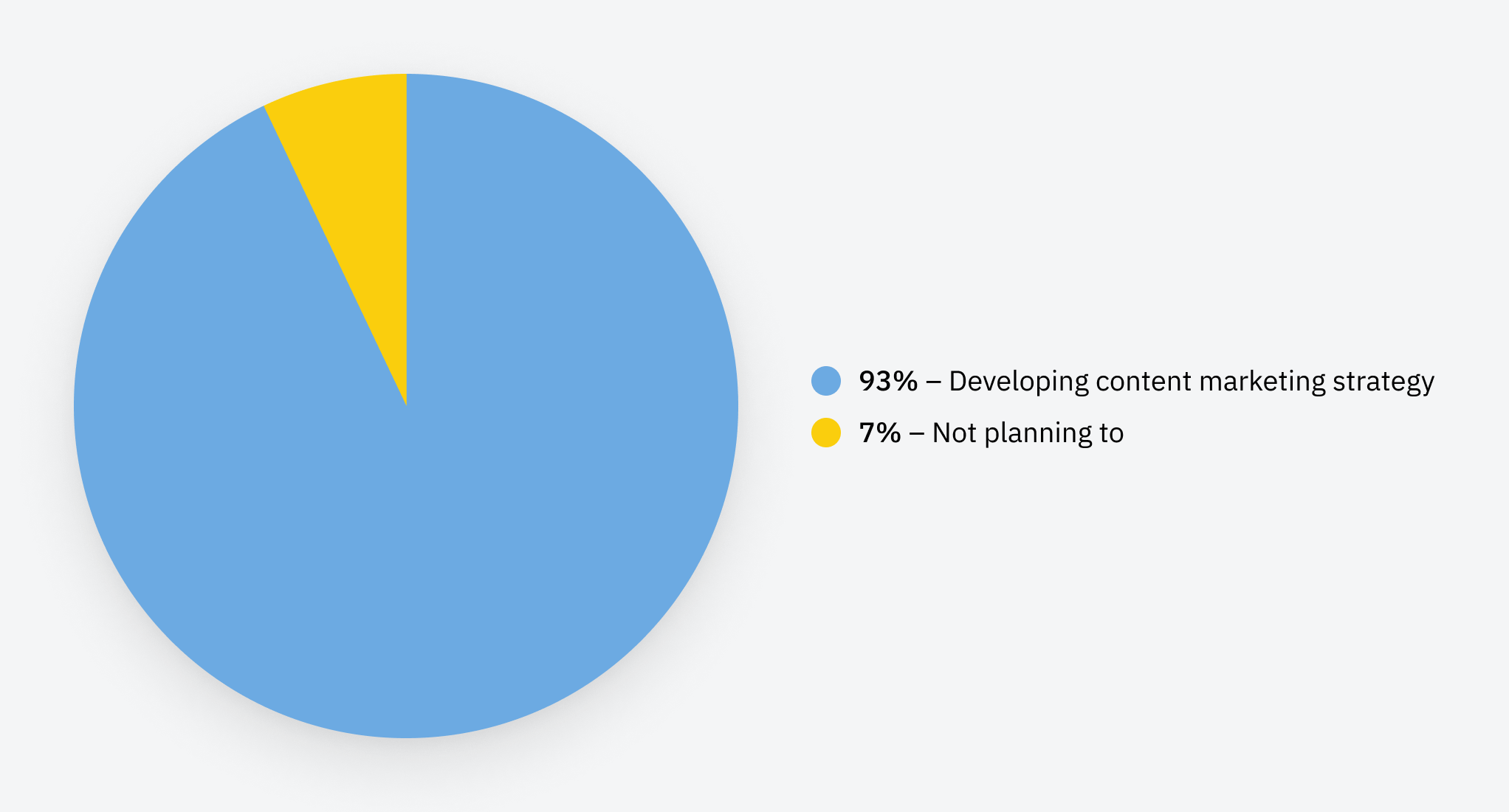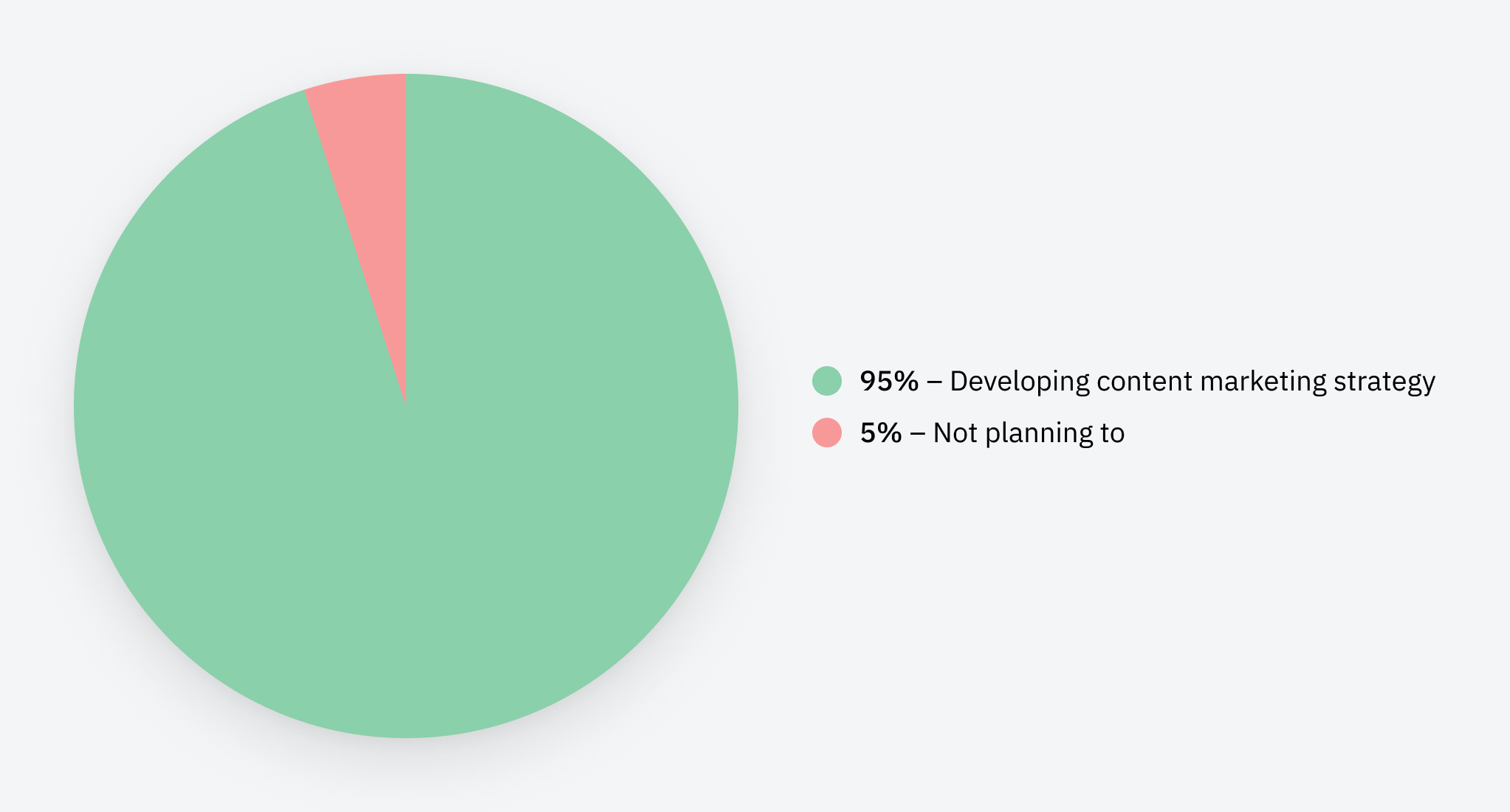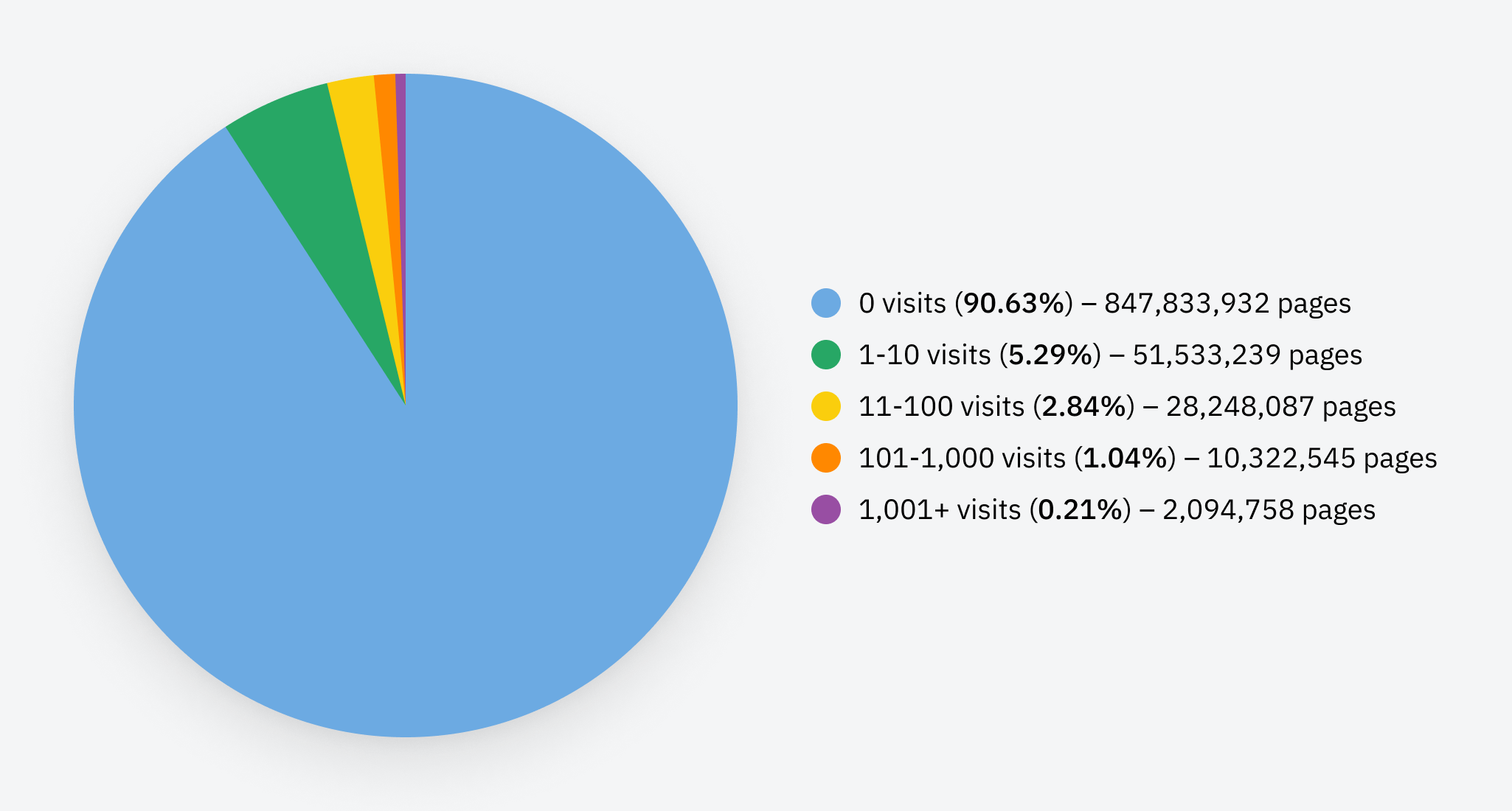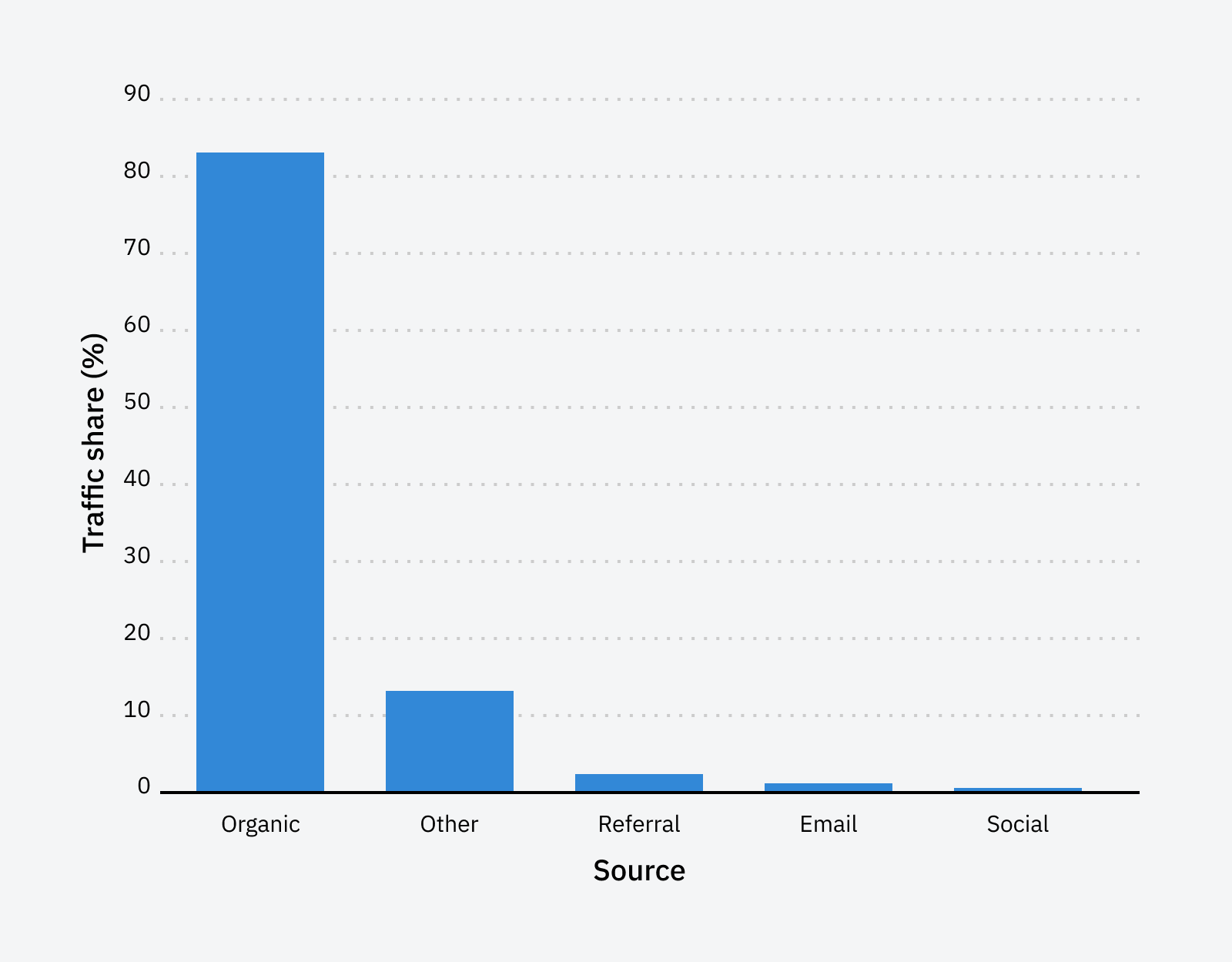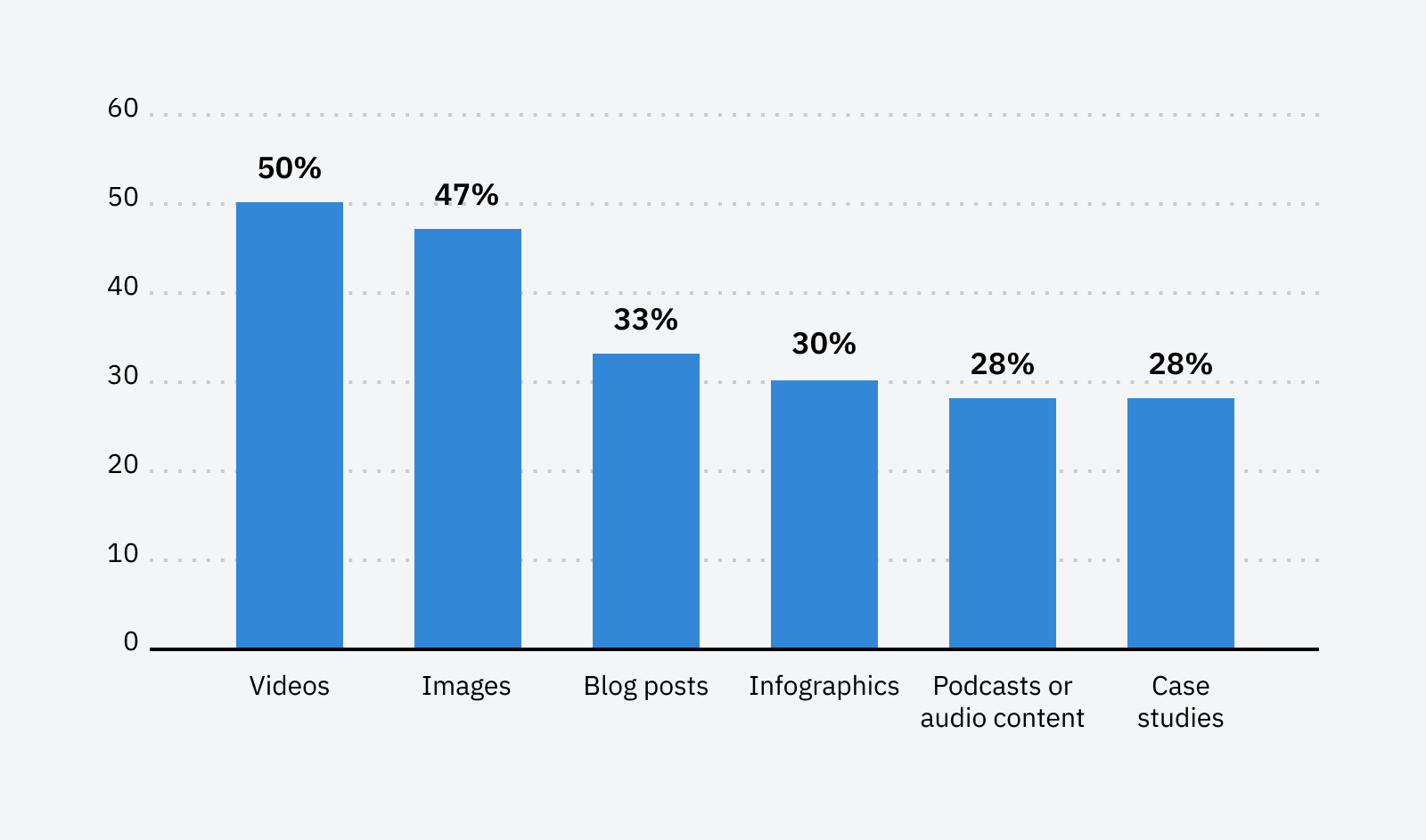Each year, we pick, vet, and categorize a list of up-to-date statistics to give you insight from hundreds of marketers on trends, best practices, or simply things that work in content marketing. This year, we have a new category: career satisfaction and the content marketing process.
This article draws exclusively from original data sources, featuring some of this year’s latest statistics alongside a few older but still relevant findings.
Content marketing has firmly established itself as the cornerstone of marketing strategies, with 82% of marketers actively investing in it and viewing it as a core business strategy. But behind the widespread adoption lies a complex, ever-evolving ecosystem filled with challenges, opportunities, and game-changing trends like artificial intelligence.
- 82% of marketers are actively investing in content marketing, 10% report not using content marketing, and 8% are unsure if their company uses content marketing. (HubSpot, 2021)
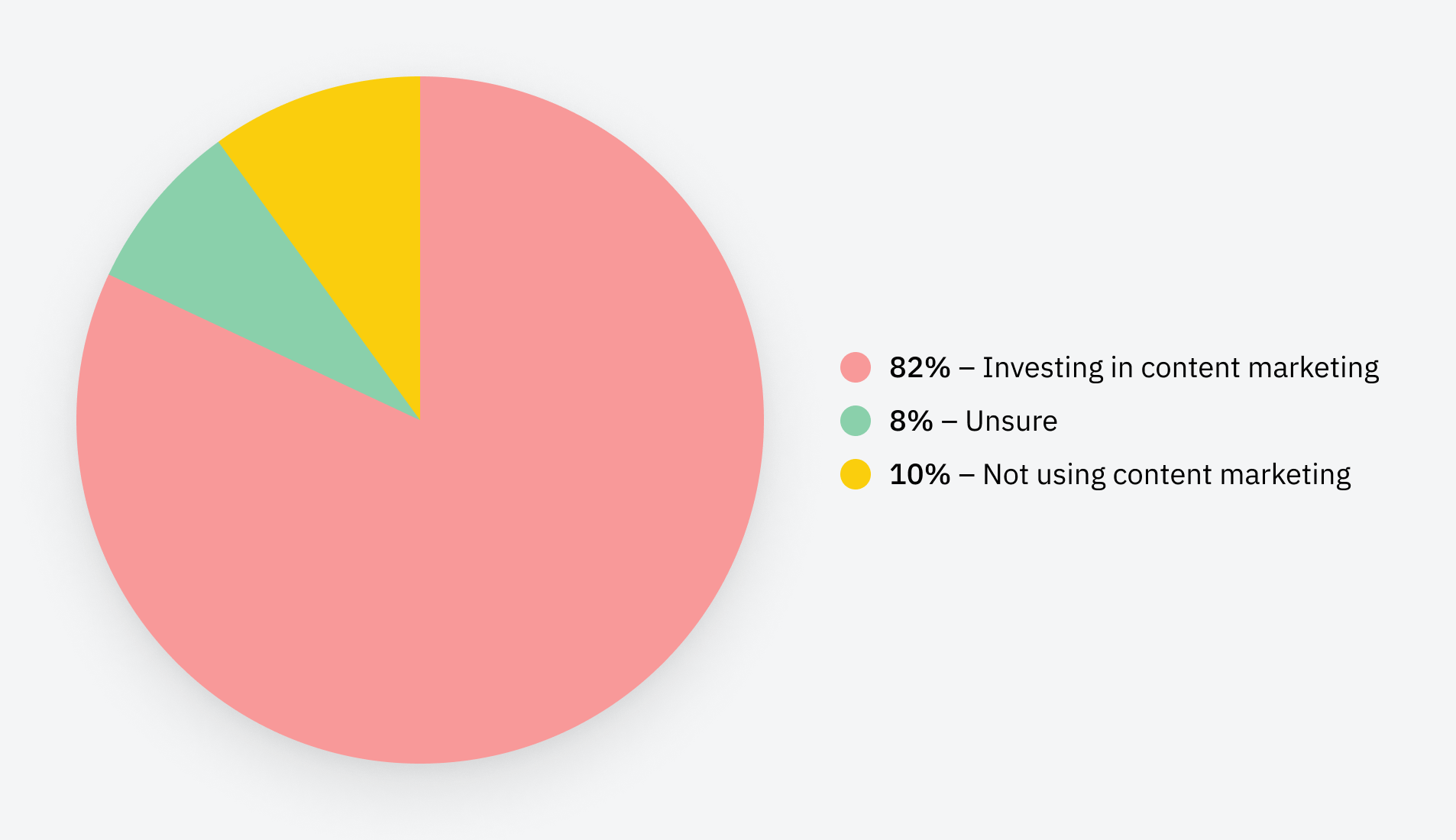
- 40% of B2B marketers have a documented content marketing strategy. That percentage is higher among the most successful B2B marketers — 64% have a documented content marketing strategy. (Content Marketing Institute, 2023)
- 69% of marketers actively invest time in SEO. (HubSpot, 2021)
- 87% of marketers report that content marketing generates demand/leads (an 11 percentage points increase since 2023). In addition, 74% of marketers say that content marketing helps to nurture the audience/customers/leads (an 11 percentage points increase since 2023), and 52% say that it helps build loyalty with existing clients/customers (a 2 percentage points decrease). (CMI, 2024)
- The most successful bloggers achieve their results by collaborating with influencers, publishing articles over 2,000 words, incorporating plenty of visuals, consistently conducting keyword research, analyzing performance metrics, working with professional editors, and dedicating significant time to crafting their content. (Orbit Media, 2024)
- 73% of people admit to skimming blog posts, while 27% consume them thoroughly. (HubSpot, 2017)
- 51% of the businesses that invest in content marketing publish content every day. (The Manifest, 2018)
- 44% of respondents say they typically consume three to five pieces of content before engaging with a vendor. (DemandGen, 2013)
- 44% of respondents prefer to learn about a product or service from a short video (a 29 percentage point decrease since 2023). 13% prefer to read a text-based article (a 2 percentage poting increase). 5% prefer to attend a webinar (2-point increase), and 6% prefer to receive a sales call or demo (3-point increase). (Wyzowl, 2024)
- 81% of marketers view content as a core business strategy. (CMI, 2021)
- The top five uses of AI in content production are generating outlines (92%), idea generation/keyword research (88%), research assistance (80%), writing simple content sections (73%), and generating entire blogs to be edited by humans (52%). (Flying Cat, 2024)
- The top three content creation challenges for content marketers are “differentiating content” “creating the right content” and “creating ‘quality’ content”. (The Content Studio, 2024)
- Across both B2C and B2B, organic channels like email marketing and SEO outperform most inorganic channels in conversion rates. (FirstPageSage, 2024)
Last year we found that almost 80% of our respondents had already adopted AI tools in their content marketing strategies. Another 10% planned to, and only a minority of 10% didn’t plan to use any AI for content.
We conducted the poll again this year to track changes, and as expected, the number of AI adopters has risen significantly — 62.5% now use AI often, marking a 6.4-point increase. Unsurprisingly, fewer people are holding off on adopting AI.
Here’s more insight into how and why content marketers use AI.
- The top five content types created with AI are long-form top-funnel SEO content (78%), mid-funnel SEO content (67%), product and bottom-funnel SEO content (50%), FAQ/glossary pages (48%), and landing pages/product pages (41%). (Flying Cat, 2024)
- Marketers who don’t use AI cite accuracy concerns (CMI, 2024)
- Nearly half of marketers (45%) don’t have any AI usage guidelines in their companies (CMI, 2024).
- 85% of marketers report that AI improved content quality. (Rockcontent, 2024)
- 84% of marketers said AI tools enhanced efficiency in creating content. (Rockcontent, 2024)
- 75% of consumers trust content written by generative AI. (Capgemini, 2023)
- 68% of marketers said that AI helped them grow their careers. (Hubspot, 2024).
- Nearly 86% of marketers say AI saves them 1+ hours a day by streamlining 86% of creative tasks. (HubSpot, 2024)
- 14% of marketers don’t edit the content produced by AI. (HubSpot, 2024)
On one hand, content marketers are experiencing rising incomes — averaging $111,352 annually, with freelancers earning even more — and enjoying the creative fulfillment that comes with producing quality work.
Yet, these wins are tempered by industry challenges, such as layoffs affecting 16% of marketers in 2023 and nearly a quarter of professionals expressing dissatisfaction with their salaries.
Beyond compensation, the ability to do meaningful, creatively satisfying work stands out as the most critical factor in career satisfaction. At the same time, content marketers are grappling with operational hurdles like accessing subject matter experts.
- The most influential factors of whether or not someone is satisfied with their career is the quality of the work they’re producing and if it allows them to produce creatively fulfilling work. (The Content Studio, 2024)
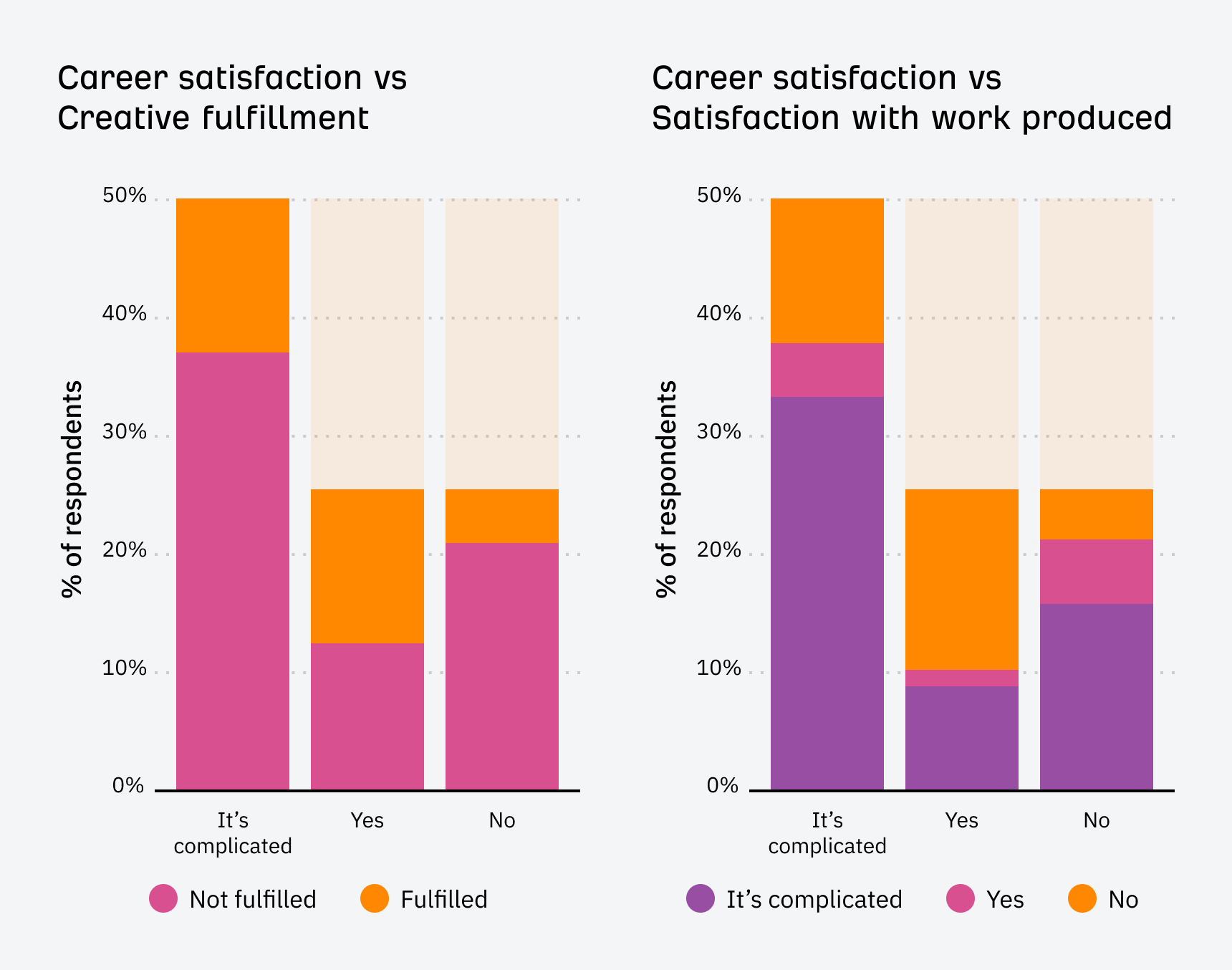
- The average total annual income of a content marketer is $111,352. This is up 16.75% over last year. (Superpath, 2024)
- Freelance content marketers make more on average than full-time employees (121,224 vs. $108,824). (Superpath, 2024)
- 16% of content marketers were laid off in 2023. (Superpath, 2024)
- 49.24% of the content marketing community reports being “satisfied” or “very satisfied” with their salary. Meanwhile, 26.46% of people report feeling neutral, and 24.30% feel dissatisfied. (The Content Studio, 2024)
- The top missing capabilities from B2B marketers’ tech stacks are efficient lead generation and nurturing processes (47%), streamlined marketing data management and reporting (47%), data-driven decision-making capabilities (45%), automation of repetitive tasks and workflows (44%), and advanced personalization options (44%). (CMI, 2024)
- The top five challenges content marketers face in managing their work are a lack of resources, difficulty accessing subject matter experts, workflow and approval bottlenecks, misalignment of content efforts across teams, and the absence of a clear strategy. (The Content Studio, 2024)
Content marketing is thriving, with most marketers prioritizing quality over quantity and leadership increasingly bought in — nearly half expect budget increases in 2025.
While unclear goals and poor alignment can hinder effectiveness, those leveraging ROI measurement, audience insights, and top-performing channels like SEO and social media are driving major results.
- 83% of marketers say it’s better to focus on quality rather than quantity of content, even if it means posting less often. (HubSpot, 2023)

- Majority of leadership is mostly bought into content marketing programs with 42% claiming they are mostly bought in and 29.9% extremely bought in. Only 2.3% don’t see the point in content marketing. (The Content Studio, 2024)
- The top marketing channels with the biggest ROI this year are websites/blogs/SEO (16%), social media shopping tools like Instagram Shops (16%), followed by paid social media content (14%), email marketing (14%), and content marketing (14%). (HubSpot, 2024)
- Only 16% of marketers rate their content strategy as ineffective. They report a lack of clear goals, being unrelated to the customer journey, not being data-driven, and ineffective audience research as the top reasons for this (CMI, 2024).
- Nearly half of the marketers say their content marketing budget will increase in 2025. 13% say it’s going to decrease, and 41% say it’s going to stay the same. (CMI, 2024)
- The top three primary goals of creating content are boosting sales, building relationships with customers, and increasing brand awareness. (eMarketer, 2019)
- Content marketing generates over 3x as many leads as outbound marketing and costs 62% less. (Demand Metric)
- 72% of the most successful marketers in North America measure the ROI of their content marketing. (eMarketer, 2018)
B2B content marketing is more essential than ever, with only 7% of marketers skipping this strategy.
Videos, case studies, and e-books top the list of high-performing assets, driven by a focus on audience needs over sales pitches.
Success comes from understanding your audience, producing quality content, and leveraging expertise — all while using platforms like LinkedIn, favored by 85% of marketers.
Looking ahead, investments in video, thought leadership, and AI signal the future of content marketing, while SEO remains a staple with 78% relying on keyword research. Despite these advancements, a surprising number of marketers still overlook X, leaving room for growth in this evolving field.
- Only 7% of B2B marketers don’t plan to develop a content marketing strategy. (CMI, 2023)

- The top 3 performing B2B content assets in 2024 were videos, case studies/customer stories, and e-books/white papers. (CMI, 2024)
- Top-performing B2B content marketers attribute their success to understanding their audience (82%), producing high-quality content (77%), possessing industry expertise (70%) and high-performing team members (69%). (CMI, 2024)
- 87% of B2B marketers prioritize the audience’s informational needs over the organization’s sales/promotional messages. (CMI, 2021)
- Over a third of marketers don’t use X for content marketing (a 12-point increase since last year). (CMI, 2024).
- 85% of marketers voted for LinkedIn as the best-performing social media platform, followed by Facebook (28%) and YouTube (22%). (CMI, 2024)
- Top areas where content marketers expect to see an investment increase are: videos, thought leadership content, and AI for content optimization/performance increase. (CMI, 2024)
- 78% of B2B marketers employ keyword research for SEO while creating content. (CMI, 2020)
Only 5% of B2C marketers opt out of content marketing as a strategy and 65% prioritize audience needs over promotional messaging. Short articles, videos, and data visualizations lead the way as top-performing content assets, while platforms like Facebook, LinkedIn, and Instagram deliver the best results for organic social strategies.
Paid distribution is also a key focus, with only 22% of marketers skipping this approach, while SEO remains foundational, with 73% using keyword research to guide their content creation.
- Only 5% of B2C marketers don’t plan to develop a content marketing strategy. (CMI, 2021)

- 65% of B2C marketers prioritize the audience’s informational needs over the organization’s sales/promotional messages. (CMI, 2021)
- Top performing B2C content assets in 2021 and 2022 were short articles (less than 3k words), videos, and data visualization/3D models. (CMI, 2022)
- B2C marketers who use nonpaid social media platforms report that Facebook (63%), LinkedIn (53%), and Instagram (39%) produced the best overall content marketing results. (CMI, 2021)
- Only 22% of B2C marketers don’t use paid content distribution channels. (CMI, 2021 )
- 73% of B2C marketers employ keyword research for SEO when creating content. (CMI, 2021)
- With a 2.8% conversion rate, email marketing outperforms all other organic channels for B2C. (FirstPageSage, 2024)
Organic search is definitely one of the biggest channels for content marketing. No wonder — consumers still like to use Google to learn and buy products and services. And that’s where content marketers fight for their attention while trying to “prove” to Google that they deserve the best spot in search results.
- 96.55% of pages get no organic search traffic from Google. (Ahrefs, 2023)

- 68% of online experiences begin with a search engine. (Brightedge, 2019)
- Google is the most widely used search worldwide, with 89.33% of the market (as of October 2024). That’s a 2-point decrease from last year. (Statcounter, 2024).
- 71% of B2B researchers start their research with a generic search instead of a branded search. (Google, 2015)
- 53% of shoppers say they always do research before a purchase to ensure they are making the best possible choice. (Google, 2018)
- Only 5.7% of pages will rank in the top 10 search results within a year of publication. (Ahrefs, 2017)
- Almost two-thirds of global online searches comes from mobile devices. (Perficient, 2021)
- Generally speaking, the more backlinks a page has, the more organic traffic it gets from Google. (Ahrefs, 2023)
- The average #1 ranking page will also rank in the top 10 for nearly 1,000 other relevant keywords. (Ahrefs, 2017)
- 40% of search ads are shown on top of organic pages of the same website. Close to 65% of these “organic pages” rank in Top 3. (Ahrefs, 2024)
Blogging remains a powerhouse for driving organic traffic, with 85% of all blog visits coming from search engines. However, the way people engage with blogs is complicated — most readers scan rather than read word-for-word, and their engagement tends to drop after seven minutes.
- 85.19% of all blog traffic comes from organic search. (Animalz, 2021)

- On average, engagement starts to drop after 7 minutes of reading. (Medium, 2013)
- People rarely read online — a pattern that hasn’t changed since 1997. They’re far more likely to scan than read word for word. They simply want to pick out the information that is most pertinent to their current needs. (Nielsen, 2020)
- 70% of people rather get information from blogs than traditional advertisements. (Demand Metric)
- There are more than 600 million blogs out of 1.9 billion websites in the world. Their authors account for over 6 million blog posts daily, or over 2.5 billion annually. (Web Tribunal, 2022)
Video has become the undisputed champion of content marketing, holding the top spot as the most created content type for four years straight.
Platforms like YouTube, which reaches more 18–49-year-olds than all cable TV networks combined, are driving this dominance. It’s no surprise — 70% of viewers have purchased a product after seeing it on YouTube, and 82% say videos have convinced them to try software or apps.
Short-form videos like TikToks and Instagram Reels, along with live streams, are leading the charge on social media, proving that relatable, passion-driven content beats flashy production.
With 91% of businesses using video and nearly 9 in 10 people wanting to see even more brand videos, the message is clear: if you’re not investing in video, you’re missing out on one of the most powerful ways to connect with your audience.
- Video has been voted the most often created type of content for marketing for the fourth consecutive year. (Hubspot, 2023)

- 70% of viewers bought a product after seeing it on YouTube. (Google, 2020)
- 82% of people say they’ve been convinced to buy or download a piece of software or app by watching a video (a 3 percentage point increase since last year). (Wyzowl, 2024)
- YouTube is the #1 visited website in the U.S. by organic traffic. (Ahrefs, 2024)
- YouTube reaches more 18 to 49-year-olds in an average week than all cable TV networks combined. (Google, 2018)
- Short-form videos (TikTok, IG Reels) and live streaming were the most effective formats on social media in 2022. (Hubspot, 2022)
- Video viewers say relating to their passions is 1.6X more important than content with high production quality. (Google, 2018)
- 91% of businesses use video as a marketing tool (same as last year). (Wyzowl, 2024)
- 91% of people have watched an explainer video to learn more about a product or service (a 5 percentage point decrease since last year). (Wyzowl, 2024)
- 89% of people wanted to see more videos from brands in 2023 (a 2 percentage point decrease since last year). (Wyzowl, 2024)
- The number of webinars grew by 153.4% in 2020. By 2025, the number of webinars will be 10x over the pre-pandemic level (Frost & Sullivan, 2024)
Podcasting is becoming an integral part of how Americans consume content, with 67% having listened to a podcast and nearly half tuning in just last month — a clear sign of its growing popularity. Listeners are highly engaged, with 80% sticking around for most or all of an episode, making podcasts a prime space for brands to connect authentically with their audience.
What’s even more compelling is the power of podcast ads: 46% of listeners find them non-intrusive, and just as many have purchased a product after hearing an ad. With U.S. podcast ad spending projected to hit $2.38 billion by 2025, it’s clear that brands see the potential of this highly engaged, trust-building medium.
- 67% of Americans listened to a podcast as of 2023 (a 3 percentage points increase from last year), and 47% listened to a podcast last month (a 5-point increase). (Edison Research, 2024)
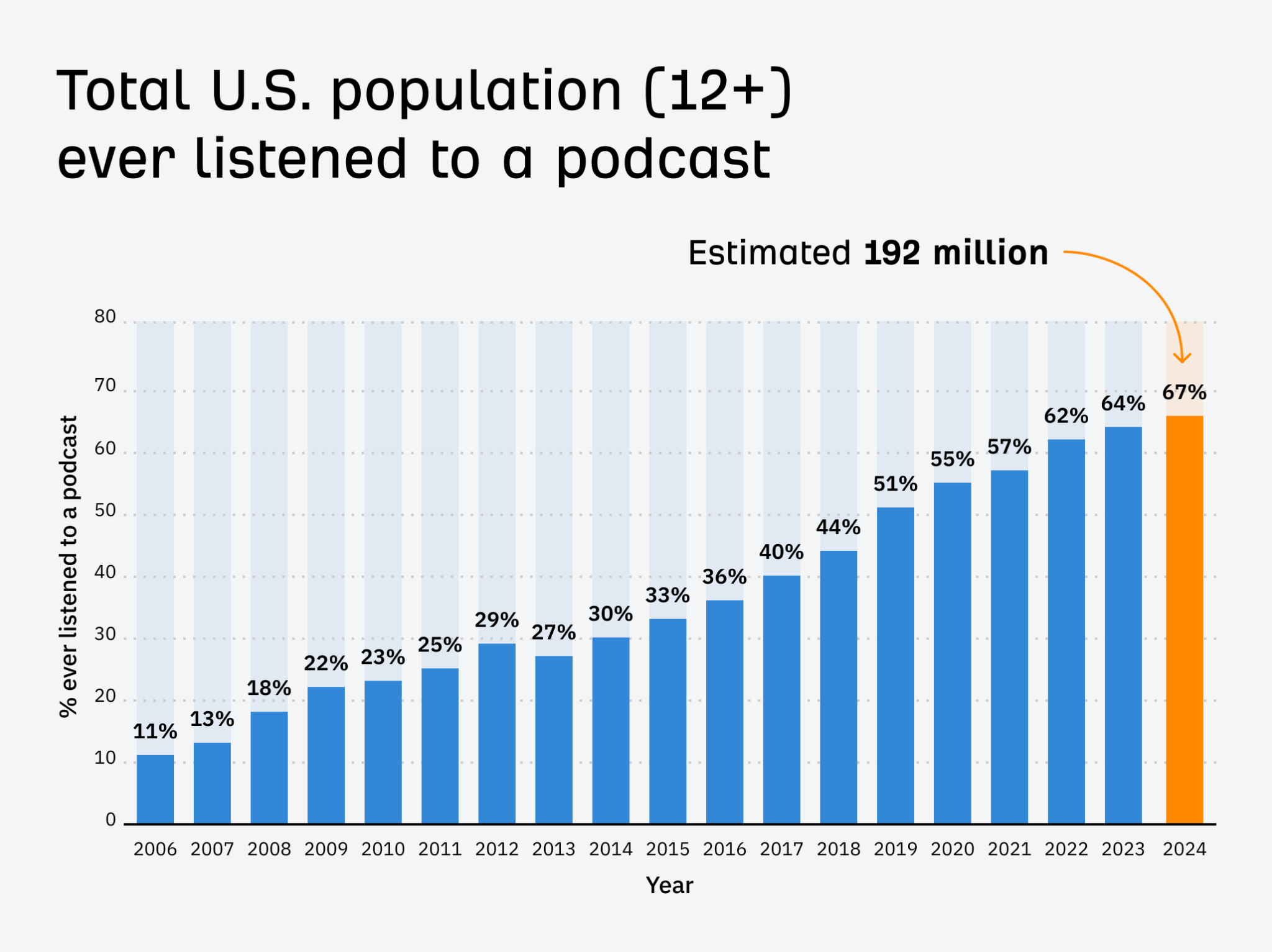
- 46% of monthly podcast listeners say that ads on podcasts are not intrusive. That’s 23 percentage points higher than YouTube. (Edison Research, 2023)
- 46% of weekly podcast listeners have purchased a product or service as a result of hearing an ad on a podcast. (Edison Research, 2024)
- 80% of podcast listeners listen to all or most of each episode. (Podcast Insights, 2021)
- Podcast ad spending in the U.S. is expected to reach $2.38B in 2025, an 18.52% increase from 2023. (Statista, 2024)
Subject lines between 61–70 characters drive the highest open rates, while personalized touches — like dynamic content or tailored subject lines — boost performance for 80% of marketers. Generative AI is also shaking up email creation, with 95% of users calling it effective.
Despite these advancements, attention spans are short: readers spend just 51 seconds on a newsletter, fully reading only 19% of the time. Incorporating videos can make a difference, increasing open rates by up to 12 points and click-through rates by over 2 points.
- Email was in the top three distribution channels for B2B content in 2024. 71% reported using newsletters and 63% using other types of email for this purpose (CMI, 2024).
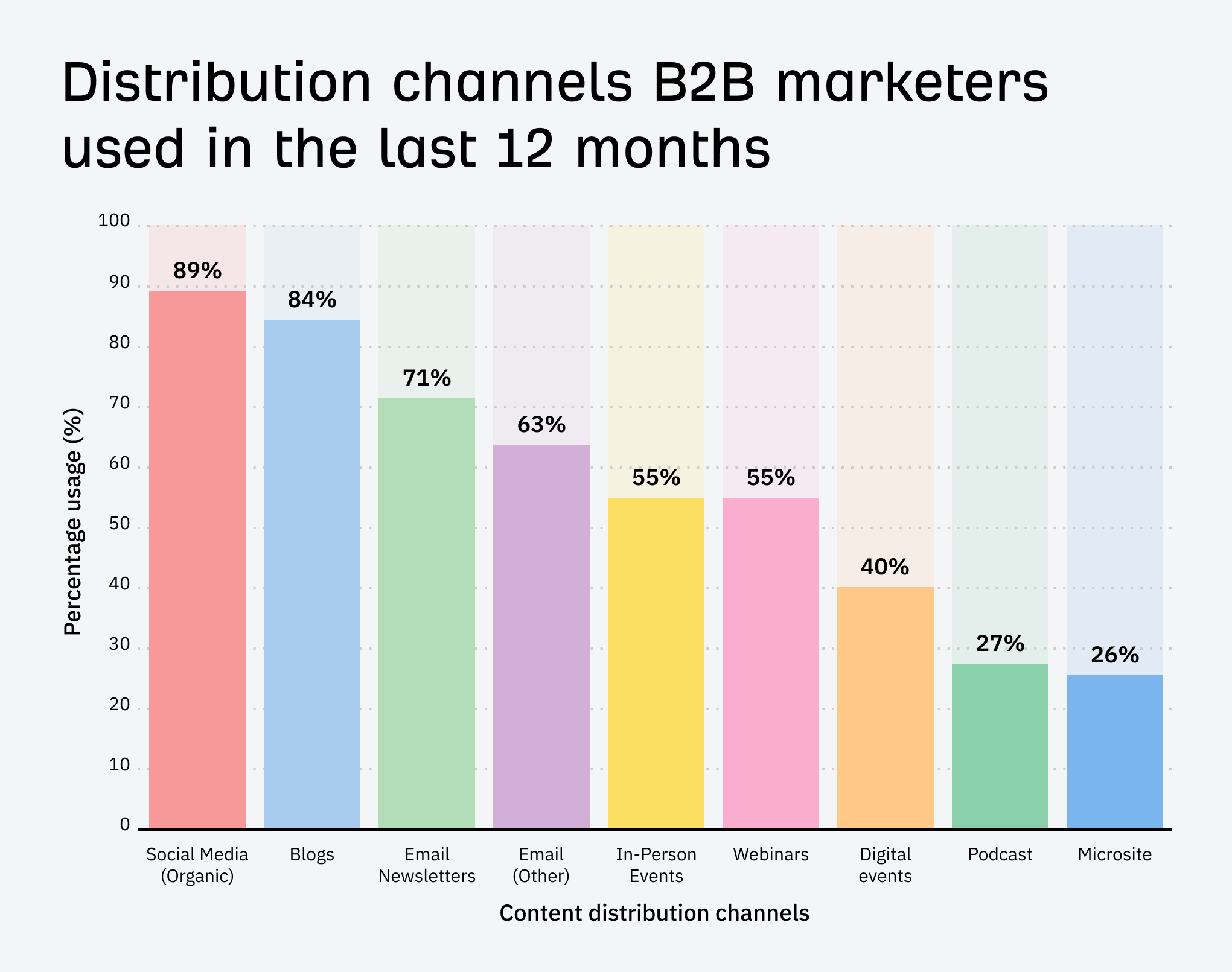
- Emails with subject lines in the 61-70 characters range have the highest open rate, on average. (GetResponse, 2024).
- The average time a reader allocates for a newsletter after opening it is only 51 seconds. Participants of the study fully read only 19% of newsletters. (Nielsen, 2006)
- 95% of marketers who use generative AI for email creation rate it “effective”, with 54% rating it “very effective.” (Hubspot, 2023)
- On average, emails containing video increased open rate by 4–12 percentage points and click-through rate by 0.97–2.04 percentage points compared to emails without embedded videos. (GetResponse, 2024)
- 80% of marketers say personalization in emails (such as subject lines or dynamic content) improves performance; only 5% don’t personalize emails. (Litmus, 2024)
Got questions or interesting data to share? Ping me on LinkedIn.
